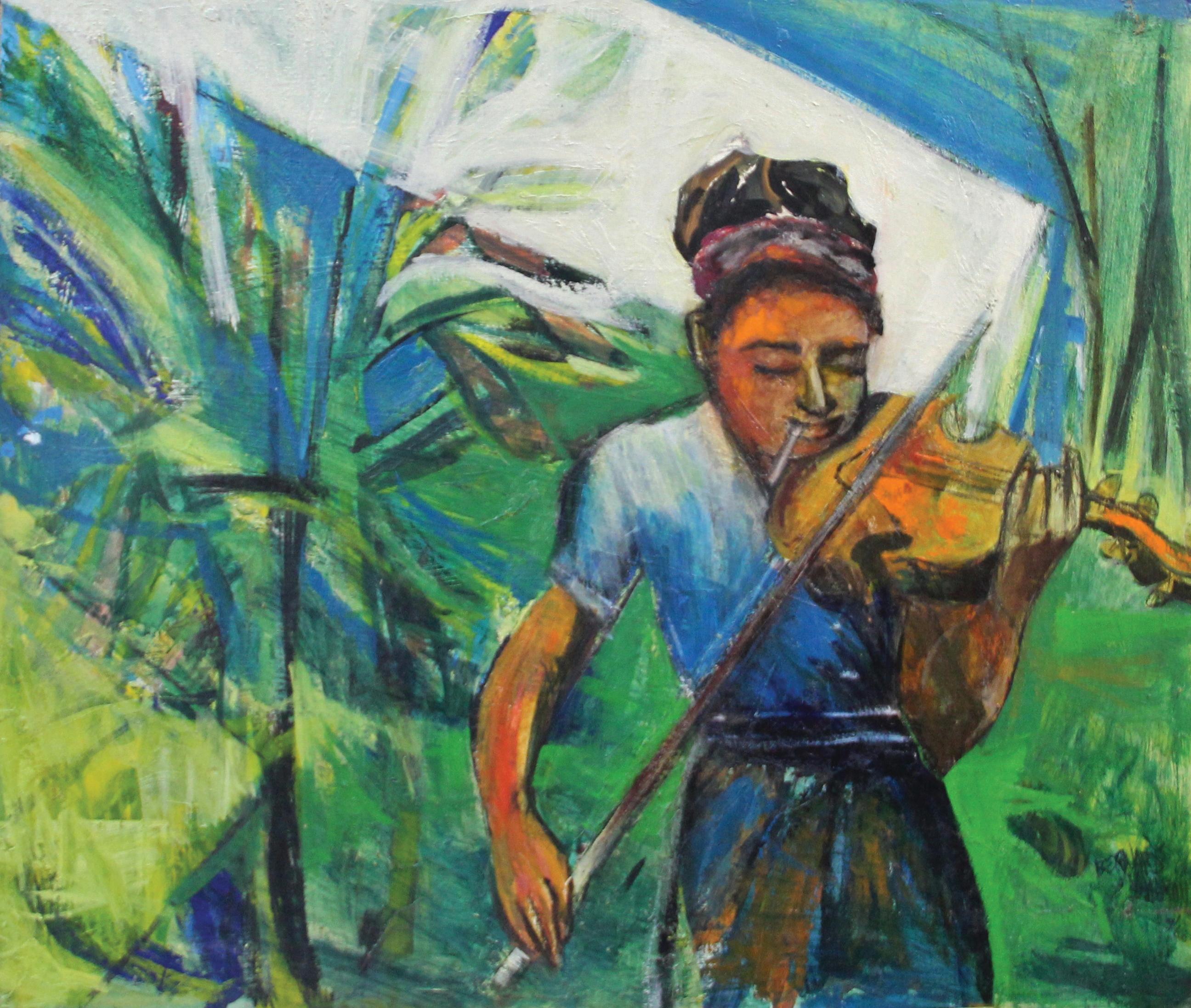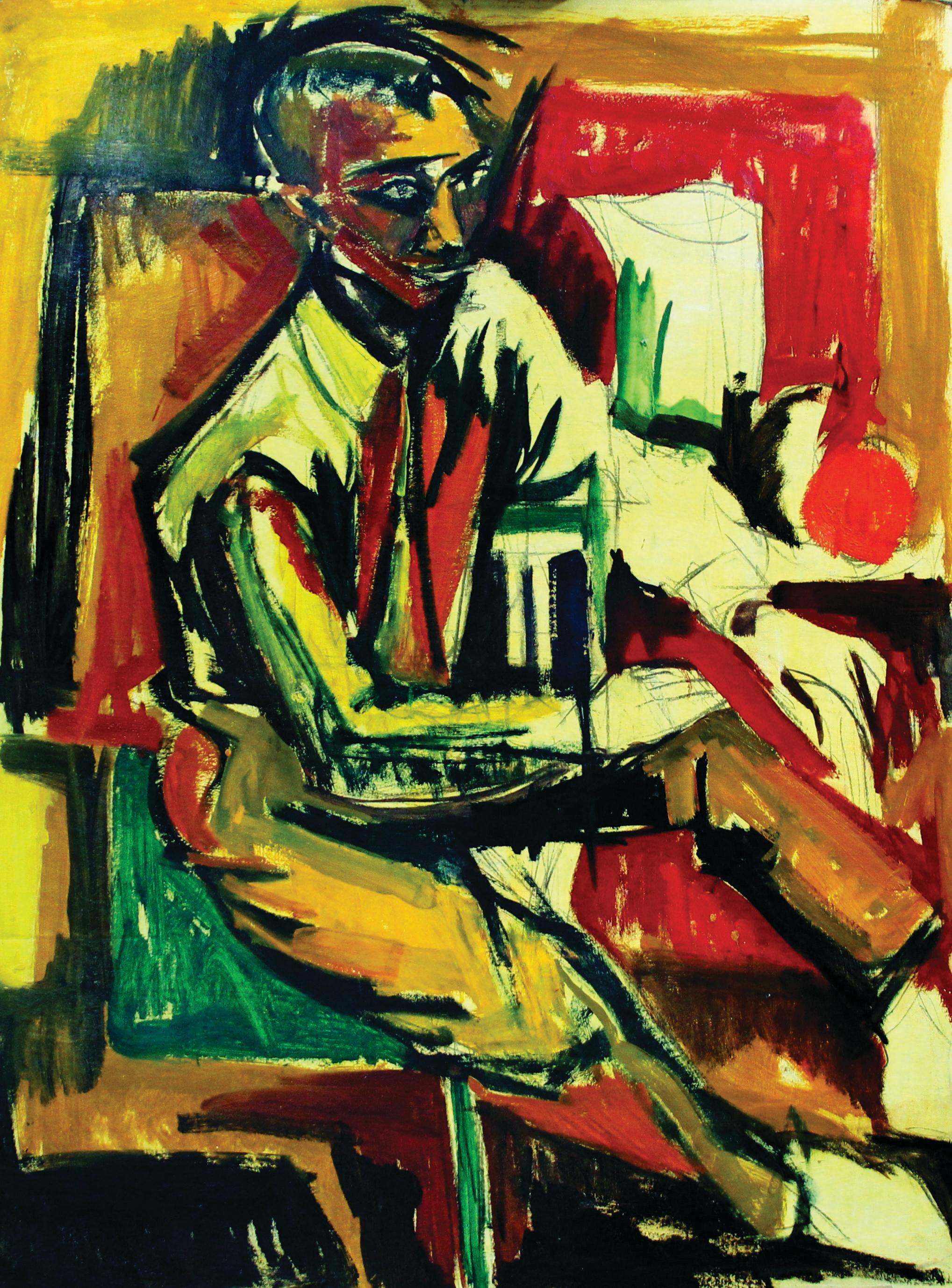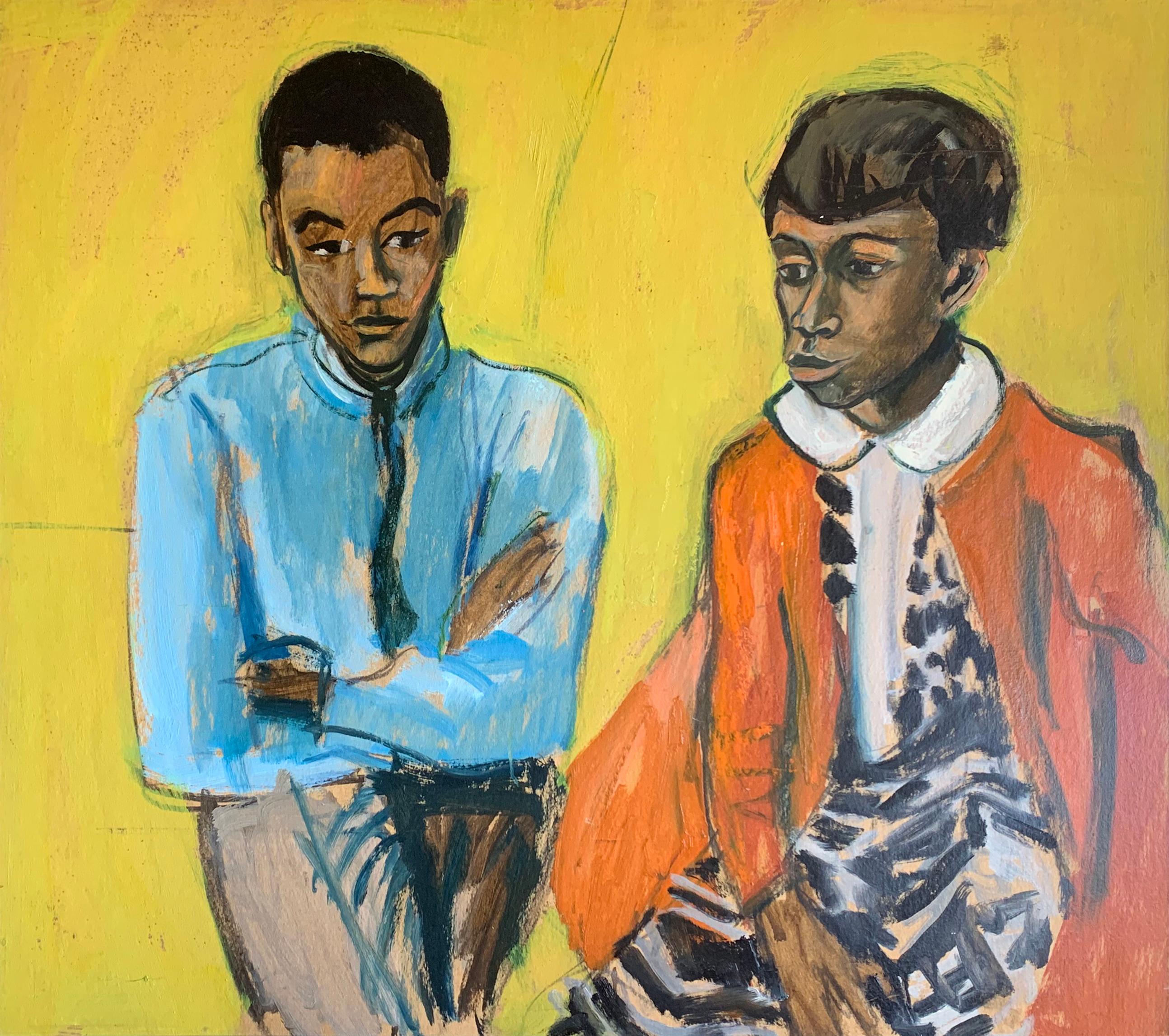Items Similar to Expressionist African American Woman Portrait German Brazilian Harry Elsas
Want more images or videos?
Request additional images or videos from the seller
1 of 10
Harry ElsasExpressionist African American Woman Portrait German Brazilian Harry Elsas
About the Item
Framed 20.5 x 18 image 14.5 x 12
Heinz Hugo Erich Elsas, (German-Brazilian 1925-1994) later known as Harry Elsas. Muralist, writer, designer best known as a painter.
Born in 1925 in Stuttgart, Germany, 1n 1936 At the age of 14 he moved with his family to Sao Paulo, Brazil fleeing from World War II and of the persecution of the Jews. A self taught artist he was influenced by the Flemish artists, his work reveals remarkable influence of Brueghel and Hieronymus Bosch. He worked in the workshop of Portinari, participating in the Tiradentes mural. His work went through a post-Expressionist phase, culminating in the adoption of cubism and is characterized by the habit of creating a three-dimensional structure before painting a picture. In 1945, he was working with Lasar Segall (Lithuanian Jewish and Brazilian painter, engraver and sculptor. Segall's work is derived from impressionism, expressionism and modernism. His most significant themes were depictions of human suffering, war, persecution and prostitution) and held his first solo show, at the Ministry of Education and Culture (MEC), in Rio de Janeiro, shortly thereafter. From 1946 to 1953, Elsas resided in Northeast Brazil, where he was strongly influenced by both- the poverty and hard working culture of the region. From 1956 through 1970, Elsas lived in Rio de Janeiro where he participated in several exhibitions. Elsas moved back to Sao Paulo. Understanding the struggles of the poor, he opened up a free art school for 3 years. After the school closed in 1974, he did several major commissioned works, including his famous mural triptych panel on Safra Bank's city wall. He was part of a generation of European born Jewish artists who settled in Brazil, such as Abraham Palatnik, Robert Burle Marx, Nelson Leirner and Gershon Knispel.
- Creator:Harry Elsas (1925 - 1994)
- Dimensions:Height: 20.5 in (52.07 cm)Width: 18 in (45.72 cm)
- Medium:
- Movement & Style:
- Period:
- Condition:needs new frame.
- Gallery Location:Surfside, FL
- Reference Number:1stDibs: LU3829391922
About the Seller
4.9
Platinum Seller
These expertly vetted sellers are 1stDibs' most experienced sellers and are rated highest by our customers.
Established in 1995
1stDibs seller since 2014
1,539 sales on 1stDibs
Typical response time: 1 hour
- ShippingRetrieving quote...Ships From: Surfside, FL
- Return PolicyA return for this item may be initiated within 3 days of delivery.
More From This SellerView All
- Polish Born Boston Expressionist Oil Painting WPA Artist Colorful Modern WomanBy Josef PresserLocated in Surfside, FLPortrait of a modernist lady or a harlequin. Emigrating to Boston in 1913 from Lublin, Poland with his Russian-Jewish parents, Presser was admitted in 1921 at age 12 to the Boston M...Category
Mid-20th Century Expressionist Figurative Paintings
MaterialsOil, Board
- Large Israeli Expressionist Orientalist Oil Painting Draped Child Kibbutz ArtBy William WeintraubLocated in Surfside, FLWilliam (Sunny) Weintraub, Israeli (Born 1926) Oil on masonite William Weintraub (He was also known as Shlomo Weintraub and nicknamed Sonny Weintraub) Genre: Impressionist Subject: Portrait Medium: Oil Surface: Canvas Dimensions: framed 24 X 32.5 canvas 19 X 27 In an ever-changing art world that embraces one movement after the next, the timeless art of portraiture can become lost. Portraiture is often associated with the royal paintings of centuries-old French kings, European nobility, and other wealthy individuals from art history's past. However, styles like Social Realism and Dutch genre painting spotlighted...Category
Mid-20th Century Expressionist Figurative Paintings
MaterialsCanvas, Oil, Board
- Modernist Orchestra Musical Gouache Painting Boston ExpressionistBy David AronsonLocated in Surfside, FLVery vibrant, dynamic orchestra scene reminiscent of the work of Mopp (Max Oppenheim) David Aronson, (1923-2015) son of a rabbi, was born in Lithuania in 1923 and immigrated to America at the age of five. He settled in Boston, Massachusetts where he studied at the school of the Museum of Fine Arts under Karl Zerbe, a German painter well known in the early 1900s. Aronson later taught at the school of the Museum of Fine Arts for fourteen years and founded the School of Fine Art at Boston University where he is today a professor emeritus. An internationally renowned sculptor & painter, Aronson has won acclaim for his interpretation of themes from the Hebrew Talmud and Kabala. His best known works include bronze castings, encaustic paintings, and pastels. His work is included in many important public and private collections, and has been shown in several museum retrospectives around the country. He is considered to be one of the most important 20th century American artists. At twenty-two David Aronson had his first one-man show at New York's Niveau Gallery. The next year, six of his Christological paintings were included in the Fourteen Americans exhibition at Manhattan's Museum of Modern Art where Aronson’s work was included alongside abstract expressionists Arshile Gorky, Robert Motherwell and Isamu Noguchi. In the 1950s, Aronson turned more toward his Jewish heritage for the inspiration for his art. Folklore as well as Kabalistic and other transcendental writings influenced his work greatly. The Golem (a legendary figure, brought to life by the Maharal of Prague out of clay to protect the Jewish community during times of persecution) and the Dybbuk (an evil spirit that lodges itself in the soul of a living person until exorcised) frequently appear in his work. In the sixties, Aronson turned to sculpture. His work during this period is best exemplified by a magnificent 8’ x 4’ bronze door which now stands at the entrance to Frank Lloyd Wright's Johnson Foundation Conference Center for the Arts in Racine, Wisconsin. In the seventies and eighties, Aronson continued his work in pastel drawings, paintings, and sculptures, often exploring religion and the frailties of man's nature. During this time, in addition to a traveling retrospective exhibition and many one-man shows in New York, Los Angeles, Chicago, and Boston at the Pucker-Safrai Gallery on Newbury Street, Aronson won many awards and became a member of the National Academy of Design in New York. Two years ago he retired from teaching to work full-time in his studio in Sudbury, Massachusetts. included in the catalog Contemporary Religious Imagery in American Art Catalog for an exhibition held at the Ringling Museum of Art, March 1-31, 1974. Artists represented: David Aronson, Leonard Baskin, Max Beckmann, Hyman Bloom, Fernando Botero, Paul Cadmus, Marvin Cherney, Arthur G. Dove, Philip Evergood, Adolph Gottlieb, Jonah Kinigstein, Rico Lebrun, Jack Levine, Louise Nevelson, Barnett Newman, Abraham Rattner, Ben Shahn, Mark Tobey, Max Weber, William Zorach and others. Selected Awards 1990, Certificate of Merit, National Academy of Design 1976, Purchase Prize, National Academy of Design 1976, Joseph Isidore Gold Medal, National Academy of Design 1976, Purchase Prize in Drawing, Albrecht Art Museum 1975, Isaac N. Maynard Prize for Painting, National Academy of Design 1973, Samuel F. B. Morse Gold Medal, National Academy of Design 1967, Purchase Prize, National Academy of Fine Arts 1967, Adolph and Clara Obrig Prize, National Academy of Design 1963, Gold Medal, Art Directors Club of Philadelphia 1961, 62, 63, Purchase Prize, National Institute of Arts and Letters 1960, John Siimon Guggenheim Fellowship 1958, Grant in Art, National Institute of Arts and Letters 1954, First Prize, Tupperware Annual Art Fund Award 1954, Grand Prize, Third Annual Boston Arts Festival 1953, Second Prize, Second Annual Boston Arts Festival 1952, Grand Prize, First Annual Boston Arts Festival 1946, Traveling Fellowship, School of the Museum of Fine Arts 1946, Purchase Prize, Virginia Museum of Fine Arts 1944, First Popular Prize, Institute of Contemporary Art 1944, First Judge's Prize, Institute of Contemporary Art Selected Public Collections Art Institute of Chicago Virginia Museum of Fine Arts Bryn Mawr College Brandeis University Tupperware Museum, Orlando, Florida DeCordova Museum Museum of Modern Art Print Collection, New York Atlanta University Atlanta Art...Category
20th Century Expressionist Figurative Paintings
MaterialsGouache, Board
- Expressionist Judaica Rabbis Oil Painting Jewish American WPA Modernist Ben ZionBy Ben-Zion WeinmanLocated in Surfside, FLRabbinical Discussion Hand signed lower left. Provenance: bears label verso for Summit Gallery Dimensions: H 14.25" x W 8" Born in 1897, Ben-Zion Weinman celebrated his European Jewish heritage in his visual works as a sculptor, painter, and printmaker. Influenced by Spinoza, Knut Hamsun, and Wladyslaw Reymont, as well as Hebrew literature, Ben-Zion wrote poetry and essays that, like his visual work, attempt to reveal the deep “connection between man and the divine, and between man and earth.” An emigrant from the Ukraine, he came to the US in 1920. He wrote fairy tales and poems in Hebrew under the name Benzion Weinman, but when he began painting he dropped his last name and hyphenated his first, saying an artist needed only one name. Ben-Zion was a founding member of “The Ten: An Independent Group” The Ten” a 1930’s avant-garde group, Painted on anything handy. Ben-Zion often used cabinet doors (panels) in his work. Other members of group included Ilya Bolotowsky, Lee Gatch, Adolph Gottlieb, Louis Harris, Yankel Kufeld, Marcus Rothkowitz (later known as Mark Rothko), Louis Schanker, and Joseph Solman. The Art of “The Ten” was generally described as expressionist, as this style offered the best link between modernism and social art. Their exhibition at the Mercury Gallery in New York held at the same time as the Whitney Annual Exhibition of Contemporary American Painting, included a manifesto concentrating on aesthetic questions and criticisms of the conservative definition of modern art imposed by the Whitney. Ben-Zion’s work was quickly noticed. The New York Sun said he painted “furiously” and called him “the farthest along of the lot.” And the triptych, “The Glory of War,” was described by Art News as “resounding.” By 1939, The Ten disbanded because most of the members found individual galleries to represent their work. Ben-Zion had his first one-man show at the Artist’s Gallery in Greenwich Village and J.B. Neumann, the highly esteemed European art dealer who introduced Paul Klee, (among others) to America, purchased several of Ben-Zion’s drawings. Curt Valentin, another well-known dealer, exhibited groups of his drawings and undertook the printing of four portfolios of etchings, each composed of Ben-Zion’s biblical themes. He worked as a WPA artist. Ben-Zion’s work is represented in many museums throughout the country including the Metropolitan, the Whitney, and the Museum of Modern Art in New York, the Art Institute of Chicago, the Philadelphia Museum of Art and the Phillips Collection, Washington. The Jewish Museum in New York opened in 1948 with a Ben-Zion exhibition. Ben-Zion consistently threaded certain subject matter—nature, still life, the human figure, the Rabbi, the Hebrew Bible, and the Jewish people—into his work throughout his life. "In all his work a profound human feeling remains. Sea and sky, even sheaves of wheat acquire a monolithic beauty and simplicity which delineates the transient as a reflection of the eternal. This sensitive inter- mingling of the physical and metaphysical is one of the most enduring features of Ben-Zion's works." (Excerpt from Stephen Kayser, “Biblical Paintings,” The Jewish Museum Catalogue, 1952). Mystical Imprints: Marc Chagall, Ben-Zion, and Ben Shahn presents the print work of three prominent 20th century Jewish artists born in the Russian Empire. Among these seventy pieces are etchings and lithographs from Chagall’s Bible series...Category
Mid-20th Century Expressionist Figurative Paintings
MaterialsOil, Wood Panel
- Large Judaica Oil Painting Samuel Grodensky Hasidic Rabbi, Children in JerusalemLocated in Surfside, FLSamuel Grodensky (1894-1974) "Hassidim" Hand signed and dated "Grodensky '62" u.l., Titled verso in pencil on stretcher 31" x 27" canvas , 35 1/2" x 31 1/2" framed. Large Fauvist Expressionist Jewish Family Oil Painting This is done in an Expressionist style in Fauvist colors. Influenced by the Judaic artists of the early Israeli...Category
1960s Expressionist Figurative Paintings
MaterialsCanvas, Oil
- Modernist Encaustic Painting Portrait Boston ExpressionistBy David AronsonLocated in Surfside, FLBears old label verso from Raydon Gallery in New York city. Aronson, David 1923- David Aronson, son of a rabbi, was born in Lithuania in 1923 and immigrated to America at the age of ...Category
20th Century Expressionist Figurative Paintings
MaterialsEncaustic
You May Also Like
- Untitled - Portrait Of A Woman With Hut - XX Century Figurative PaintingLocated in Salzburg, ATAnna Kaminska, Untitled - Portrait Of A Woman With Hut - XX Century Figurative Painting ca 1950Category
1950s Expressionist Figurative Paintings
MaterialsOil, Board
- Jazz, Expressionist Portrait of Woman with Violin by Philadelphia ArtistBy Bernard HarmonLocated in Doylestown, PA"Jazz" is a figurative painting by Philadelphia born Expressionist painter Bernard Harmon from 1968. The 34" x 40" oil on board portrait features a young African American woman playi...Category
1960s Expressionist Portrait Paintings
MaterialsBoard, Oil
- Seated Figure, Male Expressionist Portrait by Philadelphia ArtistBy Bernard HarmonLocated in Doylestown, PA"Seated Figure" is a painting by Philadelphia born Expressionist painter Bernard Harmon. The 48" x 35.75" oil on board portrait is painted in energetic and bold brushstrokes, with vi...Category
1960s Expressionist Portrait Paintings
MaterialsOil, Board
- Drums, Expressionist Group Portrait of Three Musicians by Philadelphia ArtistBy Bernard HarmonLocated in Doylestown, PA"Drums" is a painting by Philadelphia born Expressionist painter Bernard Harmon. The 34" x 40" oil on board group portrait of three musicians playing t...Category
1960s Expressionist Portrait Paintings
MaterialsOil, Board
- Not Speaking, Expressionist Portrait of Mother and Son by Philadelphia ArtistBy Bernard HarmonLocated in Doylestown, PA"Not Speaking" is a painting by Philadelphia born Expressionist painter Bernard Harmon. The 36" x 40" oil on board portrait of a mother and her son is painted in a vibrant color pale...Category
1960s Expressionist Portrait Paintings
MaterialsOil, Board
- Striped Dress and Boy, Expressionist Portrait by Philadelphia ArtistBy Bernard HarmonLocated in Doylestown, PA"Striped Dress and Boy" is a painting by Philadelphia born Expressionist painter Bernard Harmon. The 41.75" x 35.75" oil on board portrait of two figures is painted in a vibrant colo...Category
1970s Expressionist Portrait Paintings
MaterialsOil, Board
Recently Viewed
View AllMore Ways To Browse
Art From Brazil
World War Ii American
Stuttgart Germany
German Modernism
20th Century Africa Paintings
Vintage Working Woman
African Sculptors
Strong Vintage Woman
Strong Woman Vintage
Vintage Woman Picture
Solos Brazil
German Cubism
African American Woman
African Art Panels
African American Woman Artist
Harry Best
Flemish Portrait Painting
Painting German Expressionism 20th Century





